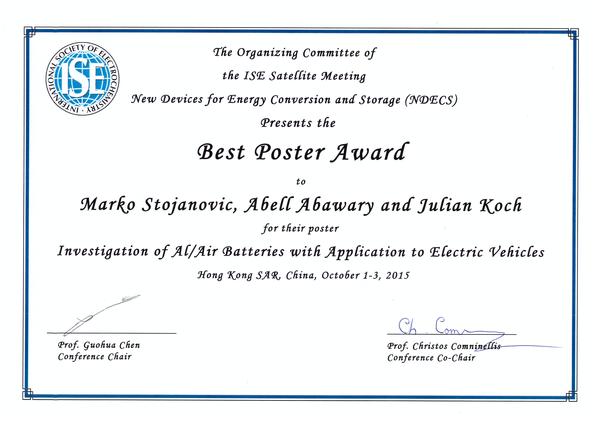EPFL Masters students receive ISE Award

Abell Abawary, Christos Comninellis, Marko Stojanovic, Julian Bernhard Koch © Ch. Comninellis/EPFL
Three Masters students at EPFL have won the 2015 Best Poster Award from the International Society of Electrochemistry.
The International Society of Electrochemistry (ISE) was founded in 1949 by leading European and American Electrochemists to serve the growing needs of electrochemistry, which was rapidly growing into a scientific discipline in its own right. Today, the ISE is a non-profit with its headquarters in Lausanne. It numbers some 3000 members, over 20 teaching institutions, non-profit-making research organizations as well as learned societies, industrial and commercial organizations. Its membership spans more than 70 industrialized and developing countries across the world, and the Society itself is organized in over 40 regional sections.
Marko Stojanovic, Julian Bernhard Koch, and Abell Abawary are all currently studying for their Masters in Chemistry and Chemical Engineering at EPFL. In an initiative sponsored by Professor Christos Comninellis (EPFL-ISIC), the course includes a scientific competition. Students are invited to give a 30-m research in presentation in electrochemical engineering. Winners are then invited to present a posted at one of the three international conferences that ISE organizes each year – a main one with two with two satellite conferences before and after.
Winning the competition in their course, the three students presented a poster at the first ISE satellite conference for 2015, which took place in Hong-Kong through 1-3 October. The award included a certificate and a monetary prize.

Their poster presents a design for aluminium-air (Al/air) batteries, which produce electricity from the reaction of oxygen in the air with aluminium. Al/air batteries use an air cathode combined with an alkaline electrolyte and an aluminum anode. Because they have one of the highest energy densities across all battery types, Al/air batteries show much promise for electrical vehicles, although the high cost of the anode currently restricts their use.
The problem that the students addressed was the formation of an aluminium hydroxide layer on the electrode’s surface during use. As a result, the battery performance and lifetime decrease.
The students solved the problem by adding a precipitation inhibitor to the system. As a result, the aluminium in the system does not precipitate, but is instead recycled. According to their calucations, the students expect that their theoretical design can allow the Al/air battery to work in a car for about 1000 km before needing maintenance.
